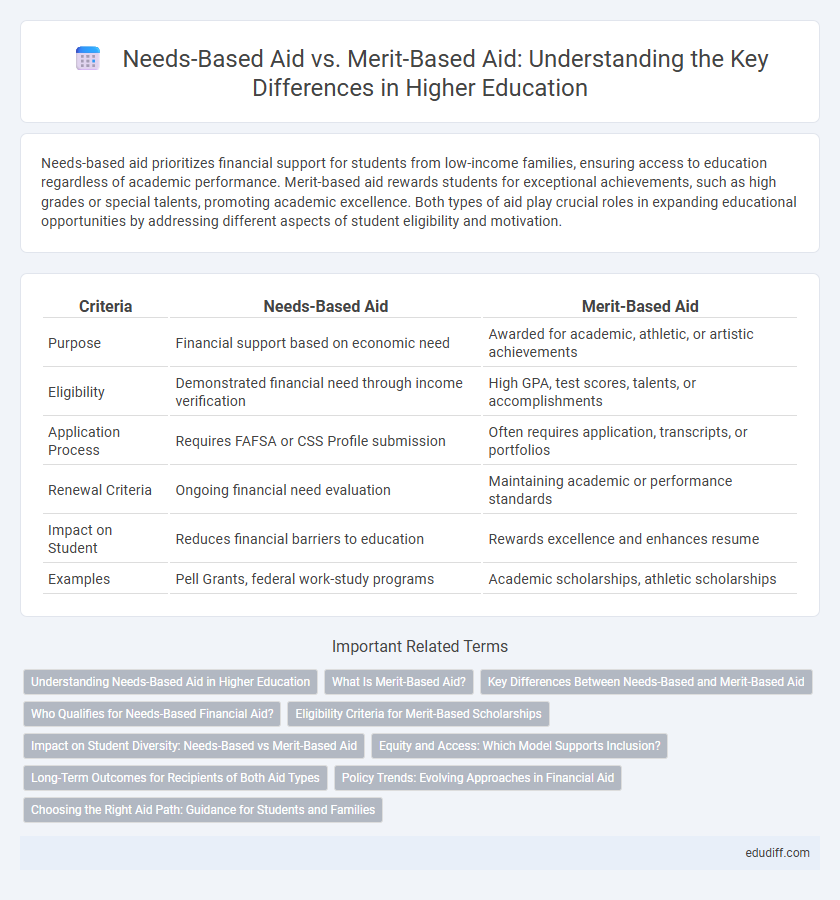Needs-based aid prioritizes financial support for students from low-income families, ensuring access to education regardless of academic performance. Merit-based aid rewards students for exceptional achievements, such as high grades or special talents, promoting academic excellence. Both types of aid play crucial roles in expanding educational opportunities by addressing different aspects of student eligibility and motivation.
Table of Comparison
| Criteria | Needs-Based Aid | Merit-Based Aid |
|---|---|---|
| Purpose | Financial support based on economic need | Awarded for academic, athletic, or artistic achievements |
| Eligibility | Demonstrated financial need through income verification | High GPA, test scores, talents, or accomplishments |
| Application Process | Requires FAFSA or CSS Profile submission | Often requires application, transcripts, or portfolios |
| Renewal Criteria | Ongoing financial need evaluation | Maintaining academic or performance standards |
| Impact on Student | Reduces financial barriers to education | Rewards excellence and enhances resume |
| Examples | Pell Grants, federal work-study programs | Academic scholarships, athletic scholarships |
Understanding Needs-Based Aid in Higher Education
Needs-based aid in higher education is financial assistance awarded to students based on their economic situation, aiming to reduce financial barriers to college access. This type of aid prioritizes applicants with demonstrated financial need as determined by standardized assessments such as the FAFSA or CSS Profile. It plays a crucial role in promoting educational equity by enabling low-income students to pursue postsecondary degrees.
What Is Merit-Based Aid?
Merit-based aid is a form of financial assistance awarded to students based on academic achievement, talents, or other specific criteria such as leadership or artistic ability. This type of aid often includes scholarships and grants that do not require repayment and are designed to reward excellence rather than financial need. Colleges and private organizations typically use standardized test scores, GPA, extracurricular achievements, and special skills to determine eligibility for merit-based aid.
Key Differences Between Needs-Based and Merit-Based Aid
Needs-based aid is awarded based on a student's financial situation, prioritizing low-income families to ensure access to higher education. Merit-based aid is granted according to academic achievements, talents, or extracurricular excellence, rewarding high-performing students regardless of financial status. Key differences include eligibility criteria, with needs-based focusing on demonstrated economic need and merit-based emphasizing individual accomplishments and potential.
Who Qualifies for Needs-Based Financial Aid?
Needs-based financial aid primarily targets students demonstrating significant financial need, assessed through factors like family income, assets, and household size reported on the Free Application for Federal Student Aid (FAFSA). Qualifying applicants often include low to middle-income families who meet federal or institutional eligibility criteria, ensuring aid is directed to those facing economic challenges. Eligibility also considers special circumstances such as disabilities or unexpected financial hardships, making this aid accessible to a diverse range of students lacking sufficient resources to afford higher education without support.
Eligibility Criteria for Merit-Based Scholarships
Merit-based scholarships primarily target students demonstrating exceptional academic achievements, leadership qualities, or artistic talents, often requiring a minimum GPA or standardized test scores. Eligibility criteria typically include high academic standing, participation in extracurricular activities, or recognition in competitions and honors. These scholarships reward past performance and potential for future success rather than financial need, distinguishing them from needs-based aid programs.
Impact on Student Diversity: Needs-Based vs Merit-Based Aid
Needs-based aid significantly enhances student diversity by providing financial support to underrepresented and low-income students, promoting equal access to higher education. Merit-based aid often favors students with high academic achievements, potentially limiting socioeconomic diversity by excluding those with financial need but less competitive credentials. Institutions prioritizing needs-based aid typically demonstrate a broader demographic representation, fostering inclusivity and reducing educational disparities.
Equity and Access: Which Model Supports Inclusion?
Needs-based aid prioritizes equity by allocating financial resources to students from low-income families, enhancing access to higher education for underrepresented groups. Merit-based aid primarily rewards academic or extracurricular achievements, which can disadvantage students lacking prior opportunities due to socioeconomic factors. Data from the National Center for Education Statistics indicates that needs-based aid increases enrollment rates among minority and first-generation college students, supporting a more inclusive campus environment.
Long-Term Outcomes for Recipients of Both Aid Types
Recipients of needs-based aid often experience improved long-term financial stability and higher graduation rates, as this support directly addresses economic barriers to education. Merit-based aid recipients typically benefit from enhanced academic opportunities and stronger career trajectories due to recognition of their achievements. Studies show that combining both aid types can maximize lifelong earnings and reduce student debt burden for diverse student populations.
Policy Trends: Evolving Approaches in Financial Aid
Policy trends in higher education increasingly emphasize a balanced approach between needs-based aid and merit-based aid to promote both equity and academic excellence. Recent legislative changes reflect a shift toward expanding need-based grant programs to reduce student debt burdens for low-income students while maintaining merit scholarships to incentivize high achievement. Institutions are adopting hybrid financial aid models that integrate data-driven assessments of economic need alongside academic performance to optimize resource allocation and student outcomes.
Choosing the Right Aid Path: Guidance for Students and Families
Students and families must evaluate financial circumstances and academic achievements carefully when choosing between needs-based aid and merit-based aid. Needs-based aid targets students with financial challenges, offering grants and scholarships that reduce education costs without repayment obligations. Merit-based aid rewards exceptional academic, artistic, or athletic performance, encouraging applicants to maintain high standards to maximize funding opportunities.
Needs-Based Aid vs Merit-Based Aid Infographic

 edudiff.com
edudiff.com